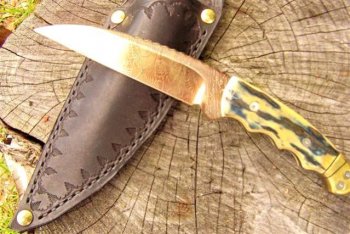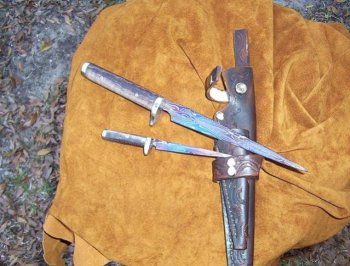A.W.Stovall
Well-Known Member
I know it uses gun bluing stuff , but for us knifemakers what is involved what do you use and why and how?
Thanks Anthony
Thanks Anthony
I rust blued this one. Made it rust then boiled it in water to turn it black. It's a lot more durable than cold blueing.
That's a nice looking dagger Calvin what did you use for the scales looks like micarta with micartsa pins and screw? nice job on the sheath also looks very well formed.
could you guys post some pics of the stuff you have blued?

 From my very limited experience carbon steel changes color at specific temperature. yellow 400f, straw 500f, purple 550f, dark blue 600f, red/grey 1000f . I'm sure this differs along with the carbon content. I have colored many knives (granted safe queens) but some colors fall into the tempering range and don't hurt anything.IMHO On some damascus you can get multi colors because of thickness diffs and shealding thro silver in the mix.
From my very limited experience carbon steel changes color at specific temperature. yellow 400f, straw 500f, purple 550f, dark blue 600f, red/grey 1000f . I'm sure this differs along with the carbon content. I have colored many knives (granted safe queens) but some colors fall into the tempering range and don't hurt anything.IMHO On some damascus you can get multi colors because of thickness diffs and shealding thro silver in the mix.Try www.SMEX.net and scroll to color chart
